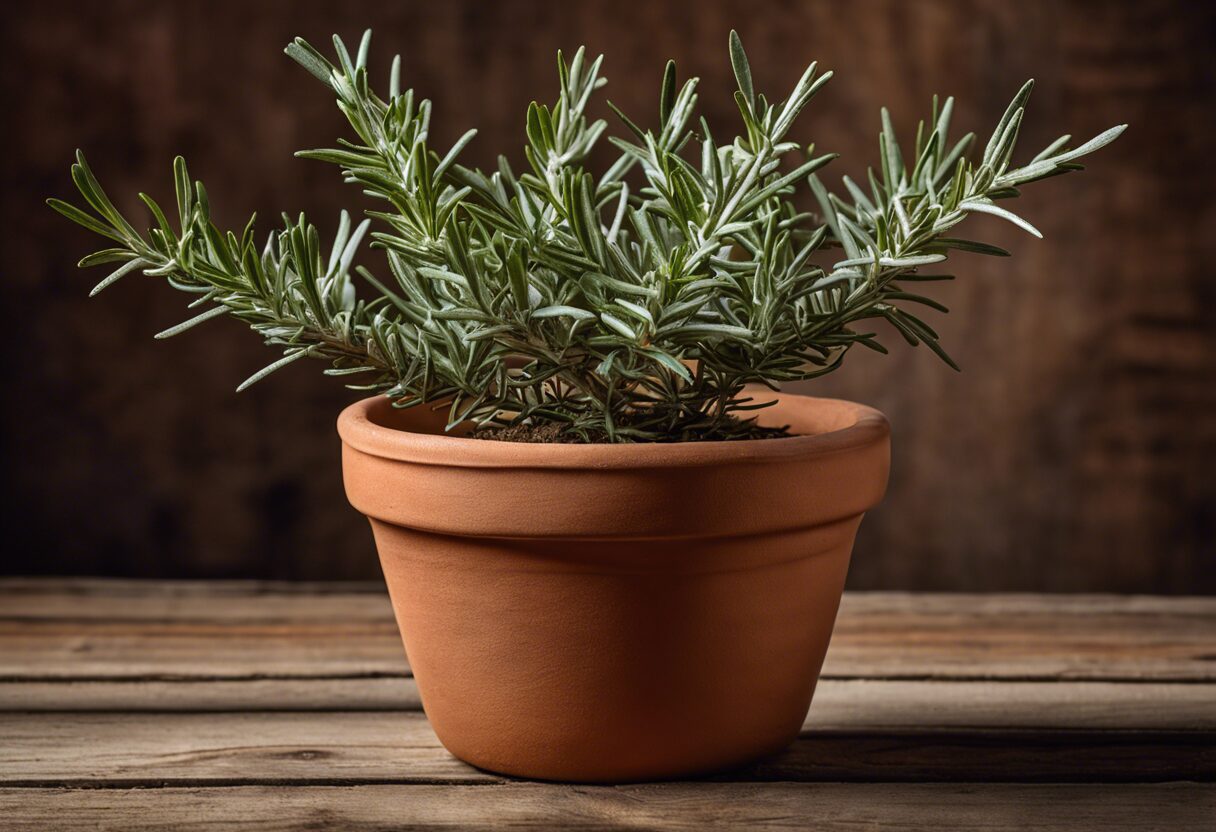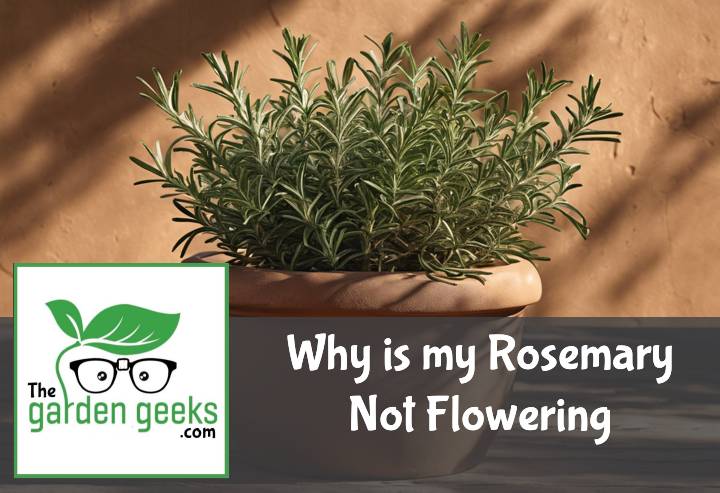Hey there, green thumbs! Ever found yourself scratching your head and asking, “Why is my Rosemary Not Flowering?” Well, you’re not alone. It’s a common query among garden enthusiasts and rosemary lovers alike.
In this blog post, we’ll dive into the nitty-gritty of why your aromatic friend might be giving you the cold shoulder when it comes to blooming. So buckle up, plant pals, it’s time to play detective in the garden! Keep reading about ‘Why is my Rosemary Not Flowering?’
Key Takeaways
- Rosemary may not flower due to insufficient sunlight, as it requires at least six to eight hours of full sun daily.
- Overwatering or poor drainage can lead to root rot, preventing flowering.
- Lack of proper nutrients, particularly phosphorus, can inhibit blooming. Fertilize with a balanced plant food.
- Pruning at the wrong time can remove potential flower buds. Avoid heavy pruning just before the blooming season.
- Rosemary plants need a period of cold dormancy in winter to trigger flowering. Indoor plants may miss this cycle.

Understanding Rosemary Plant
Let’s dive into the world of rosemary plants. We’ll explore the Rosemary plant basics, its growth cycle, and when it typically flowers. This will help us understand why your Rosemary Not Flowering might be happening.
What is a Rosemary Plant?
A rosemary plant is a perennial herb with fragrant, evergreen, needle-like leaves. It’s native to the Mediterranean region and known for its hardy nature. The plant can grow up to 1-2 meters tall, boasting beautiful blue flowers that attract pollinators like bees.
Now, onto the Uses of Rosemary plant. Apart from being a popular culinary herb used in various dishes for its distinctive flavor, rosemary also has medicinal properties. It’s been used traditionally for improving memory and relieving muscle pain and spasm.
The Growth Cycle of Rosemary
Understanding the Stages of Rosemary growth is crucial to figuring out why it might not be flowering. Initially, rosemary seeds germinate in about two weeks under optimal conditions.
Next comes the vegetative stage where the seedlings develop into mature plants over several months. During this phase, they’re busy growing their leafy branches but no flowers yet.
Finally, we reach the flowering stage which usually occurs after one or two years of growth. This is when you should expect to see those lovely blue blossoms on your rosemary plant.
When Does Rosemary Typically Flower?
The Flowering period of Rosemary varies depending on climate and care conditions but generally occurs during spring and summer months in most regions.
However, just knowing when it typically flowers isn’t enough. You need to understand the Conditions for Rosemary flowering too! These include plenty of sunlight (at least six hours daily), well-drained soil, regular pruning to encourage bushier growth and more blooms, as well as protection from harsh winter conditions.
Common Reasons for Non-Flowering Rosemary
When your Rosemary Not Flowering, it’s like a party without music. It’s just not right! There are a few common culprits that might be playing hide and seek with those lovely blooms.
| Factor | Description | Suggested Solutions |
|---|---|---|
| Light Exposure | Rosemary needs full sun to flower, typically at least 6-8 hours. | Relocate to a sunnier spot or use grow lights. |
| Soil Type | Prefers well-draining, slightly alkaline soil. | Amend soil with sand or gravel; check pH balance. |
| Watering | Over-watering or under-watering can stress the plant. | Establish regular, moderate watering schedule. |
| Nutrient Balance | Excessive nitrogen can lead to lush leaves at the expense of flowers. | Reduce nitrogen; apply phosphorus-rich fertilizer. |
| Pruning | Improper pruning can remove buds or discourage flowering. | Prune after flowering season; don't over-prune. |
| Age of Plant | Young plants may not flower in their first year. | Be patient; ensure optimal care conditions. |
| Temperature | Extreme temperatures can stress the plant. | Protect from frost; avoid extreme heat. |
| Pest and Diseases | Insects or diseases can impact flowering. | Inspect regularly; treat pests or diseases promptly. |
Insufficient Light Exposure
You see, rosemary is a bit of a sun worshipper. It loves basking in the sunlight. If your indoor rosemary not flowering, it might be throwing a fit because it’s not getting enough light. Just like us, plants can suffer from sunlight deficiency too!
So, what’s the fix? Simple! Make sure your rosemary gets at least 6 to 8 hours of full sun each day. That’s the magic number for meeting rosemary light requirements. If you’re growing indoors, place it near a south-facing window or use grow lights.
Inadequate Watering Practices
Water – too much or too little – can also cause non-flowering rosemary problems. Overwatering can lead to root rot which is like kryptonite for plants. On the other hand, underwatering can cause drought stress in rosemary.
The trick is to water when the top inch of soil feels dry to touch. This will ensure proper watering for rosemary and help avoid overwatering symptoms or underwatering effects on plants.
Lack of Proper Nutrients
Lastly, if your plant is on a diet (read: nutrient deficient), it might refuse to flower. Plants need their vitamins too! A lack of essential nutrients can turn your blooming beauty into a non-flowering wallflower.
To combat this, make sure you’re feeding your plant with balanced fertilizer designed for herbs or vegetables. This should cover all bases for rosemary nutrient needs and prevent signs of nutrient deficiency in plants.
Remember folks, happy plants make happy flowers!



Environmental Factors Affecting Flowering


When it comes to Rosemary Not Flowering, environmental factors play a significant role. From temperature swings to climate conditions, and even the quality of your garden soil, everything has an impact.
Temperature and Climate Conditions
The first thing you should know is that rosemary plants are like Goldilocks. They need their environment to be just right. Too hot or too cold, and they’ll throw a fit by not flowering. The optimal climate for rosemary is a Mediterranean one – think warm, but not scorching summers and mild winters.
Now if you’re living somewhere that’s more “Frozen” than “Mamma Mia!”, don’t lose heart. You can still grow rosemary indoors or in a greenhouse. Just remember, rosemary temperature requirements are pretty specific. They prefer temperatures between 60-70°F (15-21°C). Anything outside this range could lead to your Rosemary Not Flowering.
Soil Quality and pH Levels
Moving on from climate to the ground beneath our feet – let’s talk about soil quality. Rosemary plants aren’t too picky about their soil, but they do have some preferences. They like well-drained soil with a pH level between 6-7.
If your soil is more acidic or alkaline than this, it could be why your rosemary isn’t blooming. The effect of soil quality on rosemary flowering is significant indeed! So before you plant your next batch of rosemary seeds, make sure to test your soil’s pH levels.
In conclusion, if you’ve been wondering why your Rosemary Not Flowering, check out these environmental factors first!
Disease and Pest Issues Preventing Flowering
When your Rosemary Not Flowering, it might be due to some pesky diseases or pests. These unwelcome guests can wreak havoc on your rosemary, preventing it from reaching its full blooming potential.
Common Diseases in Rosemary Plants
One of the most common rosemary plant diseases is powdery mildew. This fungal infection leaves a white, powdery substance on the leaves and stems, which can hinder flowering.
Another culprit could be bacterial leaf spot. This disease causes brown or black spots on the leaves, which can stunt growth and prevent flowering.
Lastly, viral infections like rosemary mosaic virus can cause yellowing and curling of leaves. This not only affects the overall health of the plant but also its ability to flower.
Pests that Affect Rosemary’s Flowering
Now let’s talk about pests. Spider mites are one of the common pests in rosemary plants. These tiny critters suck out plant juices, causing damage to both foliage and flowers.
Aphids are another pest that loves to feast on rosemary. They feed on the sap of plants, causing distorted growth and reduced flowering.
Finally, we have whiteflies. These insects lay their eggs on the underside of leaves, leading to poor plant health and reduced flowering. So if you’re dealing with a case of Rosemary Not Flowering, make sure you check for these pests!
How to Encourage Your Rosemary to Flower?
To get your Rosemary Not Flowering back on track, it’s all about the basics: sunlight, water, and fertilization. Let’s dive into each one.
Providing Adequate Sunlight
Sunlight is like the magic potion for your rosemary. It’s crucial for its blooming process. The more sunlight, the happier your rosemary will be. So, make sure you’re giving your plant plenty of it!
Now, when we say ‘adequate sunlight’, we mean around 6 to 8 hours of direct exposure daily. That’s what we call Optimal light conditions. Remember, the Importance of sunlight in flowering can’t be overstated!
Ensuring Proper Watering Techniques
Watering is another key player in this game. But here’s the catch – too much or too little can both lead to a Rosemary Not Flowering situation.
The best way? Keep it moderate and consistent. This is what we call Best watering practices for rosemary plants.
How does watering influence flowering? Well, proper watering ensures that nutrients are evenly distributed throughout the plant. This boosts overall health and encourages blooming – hence the Influence of watering on flowering.
Fertilizing Your Rosemary Correctly
Lastly, let’s talk about fertilization – an often overlooked but vital factor in encouraging your rosemary to flower.
Fertilizing isn’t just about promoting growth; it also enhances your plant’s Flowering potential with correct fertilization. A balanced fertilizer (think equal parts nitrogen, phosphorus, and potassium) works wonders here.
Remember though – overdoing it with fertilizer can do more harm than good! So keep things balanced and watch as your once-Rosemary Not Flowering transforms into a blooming beauty!


To Wrap Up
In the grand scheme of things, your Rosemary Not Flowering is like a teenager refusing to clean its room. It’s not always about what you’re doing wrong, but more about what it needs to thrive. Be patient, provide adequate sunlight, water and soil conditions.
Remember, every rosemary plant has its day in the sun! Don’t be disheartened if yours is taking a bit longer. With the right care and attention, you’ll soon see those beautiful blue flowers blooming.


